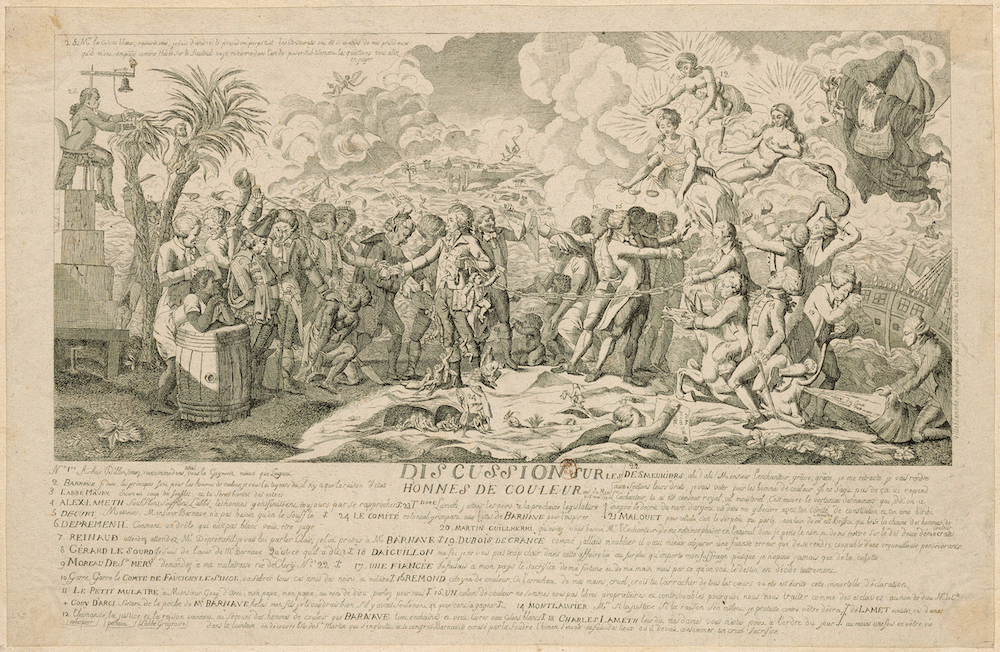Katherine Calvin
While describing Senegal in his 1797 illustrated book, Tableaux des principaux peuples de l’Europe, de l’Asie, de l’Afrique, de l’Amérique, et les découvertes des capitaines Cook, La Pérouse, etc., the white, Montreal-born author, artist, and former diplomat Jacques Grasset de Saint-Sauveur (1757-1810) explicitly condemns Europeans’ brutal treatment of enslaved Africans: “The Black man is my brother, I know, and the colonizer who wants to bring him to the level of animals, to make the same use of them, is a barbarian.”[1] Slavery metaphors had come to dominate French protest texts against unjust rule, including those by Jean-Jacques Rousseau (1712-1778) and Denis Diderot (1713-1784), during the second half of the eighteenth century. By identifying “l’homme noir” as “mon frère,” Grasset initially conveys a sense of political, even revolutionary, solidarity with “l’homme noir” against other “barbaric” Europeans supportive of slavery. This familial association, though, is quickly tempered by his assertion of categorical racial difference manifested through skin color: “however, despite this philosophy, there is nuance between him [the Black man] and the white, and this nuance is not imperceptible…he thinks like a child and corrupts himself like a man.”[2] Grasset’s text aligns visual perception with the discernment of racial differences. Within broader European discourses on human difference, association of race with skin color was largely stabilized by the time Grasset was writing at the end of the eighteenth century.[3] Consequently, sight was key to locating oneself and others within a set of racial identities and, by extension, racial hierarchies. Indeed, as Anne Lafont has argued, race had come to be understood as something manifested through reliable and legible corporeal signs that could be observed independently of its bearer’s will.[4]
Given Grasset’s stated investment in the visually perceptible nature of race, observing and depicting race—this porous signifier (to borrow Éric Michaud’s term) that encompassed biological, political, social, religious, and linguistic factors—lay at the core of many of his texts and images, particularly his late eighteenth-century depictions of la traite, or the slave trade, in Senegal. [5] In this essay, I argue that Grasset’s unusual attention to the industry’s logistics both drew from and contributed to broader discourses about French slave trade operations in Senegal, specifically. By representing the routine mechanics of mercantile exchange, these works highlight the racial and religious diversity of commercial agents in West Africa during a period in which French economic dominance in the region was increasingly contested by internal and external factions. The resulting instabilities in the Senegalese slave trade, both real and sensationalized, intersected with ongoing debates in revolutionary France about commercial regulation, the (un)naturalness of slavery, and the parameters of political liberty in relation to race and blood. Grasset’s prints negotiated the desire to render racial difference pictorially legible, and, conversely, the unreliability of visual perception in identifying legal or economic status during this fraught period of political and social change in both Senegal and France.
Jacques Grasset’s Markets
Grasset’s imagined views of Senegal (a place he never visited) have much to tell us about the commercial and demographic specificities of the late eighteenth-century slave trade. Yet in the nineteenth and twentieth centuries, his works were dismissed as mediocre, and, although widely collected, they have not received much attention from scholars working outside costume history.[6] Such neglect is certainly connected to the continued under-utilization and under-theorization of printed images in the archives of Western imperialism, as Douglas Fordham has noted.[7] And while Grasset might appear to be an unlikely commentator on the French slave trade in Senegal, in bypassing his works, we forego crucial insights about the representation of race and commerce in popular, widely circulated images.
Born in 1757 in Montreal, Grasset was the son of André Grasset de Saint-Sauveur (1724-1794), a diplomat who was indicted in the infamous “Affaire du Canada” of 1761 and later re-appointed to consular posts in southern Europe after the family’s 1764 return to France.[8] The younger Grasset initially followed in his father’s diplomatic footsteps as a vice-consul in Hungary and later as French consul in Cairo; however, he abandoned foreign service by the mid-1780s.[9] According to the only known contemporaneous source, Grasset led an eclectic life but one nonetheless marked by professional success.[10] After a theatrical venture failed, Grasset established a publishing career in Paris that capitalized on the expanding markets for travel literature, libertine fiction, and inexpensive fashion prints.[11]
Although Grasset is often credited as the designer of his images, he relied extensively on previously published images and texts. He assembled material from across a multiplicity of genres including encyclopedias, collection inventories, costume books, travel accounts, picturesque descriptions, and a variety of histories.[12] His travel- and costume-based works, in particular, provided a nearly inexhaustible source of income over multiple decades. Grasset’s ability to recycle drawings and prints from one title to another exemplified the possibilities of commercial, speculative printing in the late eighteenth century.[13] For example, after selling his privilege to the publisher Pavard for his first successful book Costumes civils actuels de tous les peuples connus (1784), Grasset continued competing in the same market with a 1788 book of the same title and, later, his Encyclopédie des voyages (1792-1796), which included more than four-hundred colored plates.[14] His near-constant release of “new” travel and costume books during the 1790s meant his works were more widely read than those of other French authors working on similar topics, but in more technical or less fashionable modes.[15]
My interest in Grasset originated from an encounter with his Costumes de différents pays (1797), a book composed entirely of 432 hand-colored plates, in the Los Angeles County Museum of Art’s collection. The prints for this monumental work were likely produced in a workshop overseen by Grasset in which multiple designers and printmakers, including Claude Louis Desrais (1746-1816), Félix Mixelle (1763-1837), J. Laroque, and L. F. Labrousse, collaborated.[16] Allegorical frontispieces divide the book into four sections dedicated to the continents Europe, Asia, Africa, and America. Of the seventy prints in the Africa section, fourteen, or twenty percent, depict individuals from Lower Senegal, including the islands of Gorée and Saint-Louis as well as the nearby regions of Waalo and Cayor.[17] Grasset’s sustained attention to this area suggests a heightened interest in Senegal among eighteenth-century French consumers. In some ways this is unsurprising: while exports from West Africa such as gold, ivory, and malagueta pepper, among others, have been in demand in Europe since the third century via trans-Saharan trade routes, Portuguese merchants established new, more direct routes to Lower Senegal in the fifteenth century. Eager to compete in this market, French traders dislodged Dutch competitors in 1638 from the strategic island of Guet N’Dar, thereafter known as Saint-Louis, and constructed the first permanent French habitation at the mouth of the Senegal River. In 1677, a French expedition also captured the island of Gorée, which became their trade entrepôt along the Petite Côte and in the Gambia River.[18] A series of French companies with exclusive privileges oversaw mercantile exchange, including the slave trade, in Lower Senegal throughout the late seventeenth and eighteenth centuries.
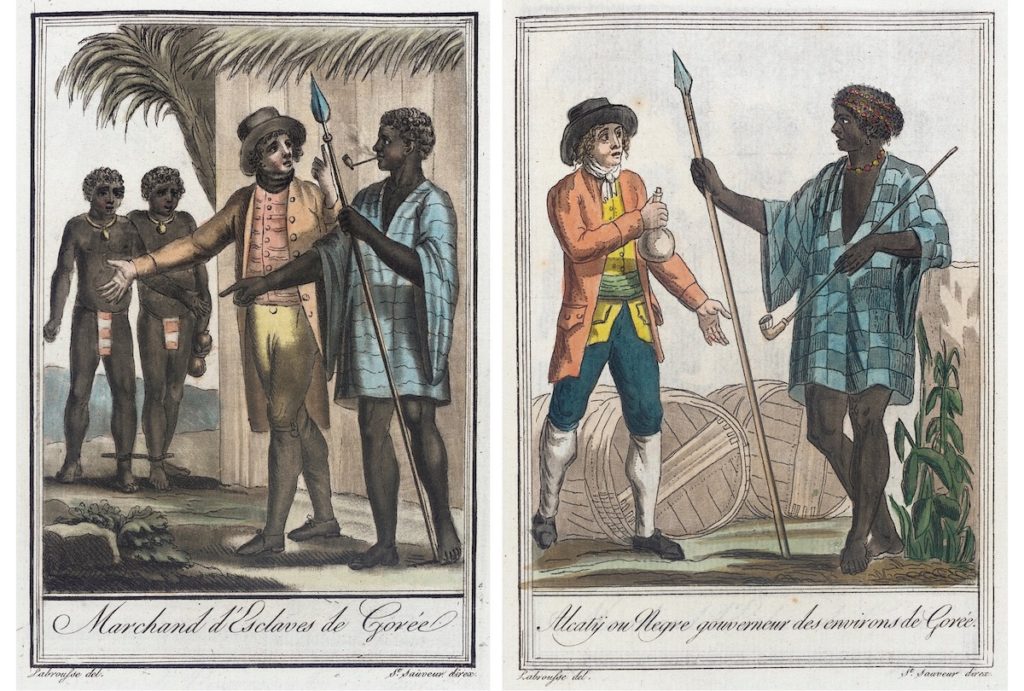
RIGHT: Fig. 2. Jacques Grasset de Saint-Sauveur and L.F. Labrousse, Alcatÿ ou Negre gouverneur des environs, in Costumes de différents pays, c. 1797. Hand-colored etching on paper, 19.69 x 13.97 cm. Los Angeles County Museum of Art.
What surprised me about Grasset’s images of Lower Senegal was their repeated, explicit representation both of the racially diverse agents involved in the slave trade and of the logistics of capture and mercantile exchange that underpinned the system. Marchand d’esclaves de Gorée (Fig. 1) and Alcatÿ ou Negre gouverneur des environs (Fig. 2), for example, both depict a white man in European-style clothing negotiating with a Black man dressed in a light blue tunic holding a long spear and pipe. In Marchand d’esclaves, both men stand at right and gesture with outstretched arms to two nearly naked Black men at left, whose gold collars and shackles signify their enslavement. The accompanying text suggests a commercial transaction is occurring; it is not immediately clear, however, which of the pair at right is the titular slave merchant. While the chromatic contrast in skin tone seems to promise a fixed distinction between both the racial identity and economic status of each figure, the narrative implied by the title provokes uncertainty. This ambiguity thwarts any conclusive interpretation based on skin color alone and instead foregrounds the Senegalese slave trade’s more complex, multi-tiered economy. Moreover, in Alcatÿ, it is not enslaved persons but two hefty barrels that appear to hold the commodity soon to be exchanged (alcohol is suggested by the bottle held by the white figure). The tobacco in the Black figure’s pipe and his colorful beads, as well as the cotton clothing worn by both, remind viewers of the many other goods traded in and/or produced by transatlantic markets. Together, the prints situate the slave trade as only one of many markets in the broader field of exchange linking Europe and Senegal.

RIGHT: Fig. 4. Jacques Grasset de Saint-Sauveur and L.F. Labrousse, Manière dont les Maures prennent les esclaves, in Costumes de différent pays. c. 1797. Hand-colored etching, 19.05 x 13.65 cm. Los Angeles County Museum of Art.
Two additional images, Negresse de qualité de l’Isle St. Louis dans le Sénégal. Accompagnée de son esclave (Fig. 3) and Manière dont les Maures prennent les Esclaves (Fig. 4) similarly portray West Africans as enslavers and raiders. The first depicts a well-dressed signare—a title given to African women of property and social standing, often of Eurafrican descent living along the Senegambian coast—who attends to a small child in the foreground and is shaded by an enslaved woman holding a parasol at left. Her subordinate status is communicated by the gold chains that crisscross her otherwise unclothed torso, which contrasts with the voluminous dress and wrapper worn by the signare. As in Marchand d’esclaves, Grasset’s print communicates the economic agency of certain Senegalese locals through their physical proximity to the exchange or ownership of other enslaved Africans.
These works register the very real social and commercial influence of Senegal’s Eurafrican community, many of whom were descended from Lançados, or Portuguese merchants allowed to live in coastal communities with local women beginning in the fifteenth century.[19] As translators as well as commercial agents, the signares were part of the broader population of habitants, which encompassed free residents (both Black and métis, or of mixed-race Eurafrican heritage) who had acquired capital in Saint-Louis and Gorée.[20] Collectively, they formed a multi-racial class with the cultural and commercial dexterity to move between British, French, or African authorities.[21] Habitants were thus essential facilitators of French slave trade operations and, as I will later discuss, acted collectively to protect their interests in the late eighteenth century. The origins of much of the slave trade’s supply chain, however, extended beyond coastal Senegal to northwest Africa’s interior states, namely the Mandinka state of Kaabu and the Fula Imamate of Futa Jallon, which provided war captives to Senegal’s slave markets.[22] Manière dont les Maures prennent les Esclaves (Fig. 4) depicts such a moment of enslavement. Brandishing a sword and reaching forward with his left arm, a mounted rider explicitly identified as a Moor in the title appears poised to overtake the man fleeing on foot at left. A captured female figure with wrists bound to the horse follows with shoulders hunched. A small child rides behind the central figure, and it is unclear whether this figure, too, has been enslaved during the depicted raid.
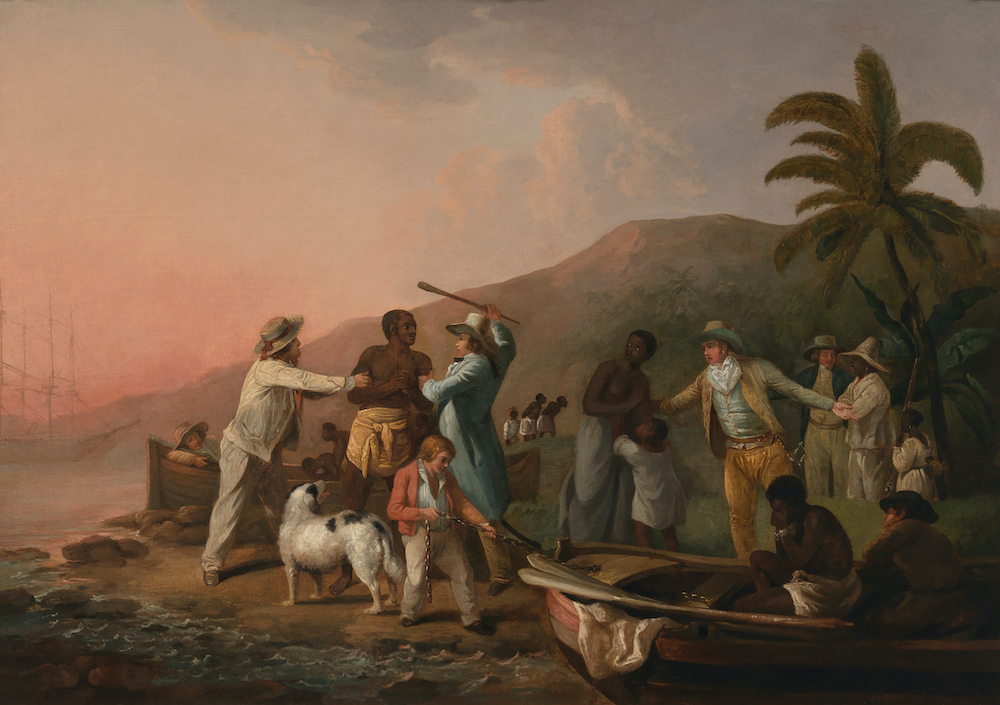
Picturesque representations of slavery these are not; but neither do they linger on corporeal suffering as a way to provoke a sentimental reaction, as did much abolitionist imagery. They operate differently from, for example, the first recorded painting of slave trading, George Morland’s Execrable Human Traffick, or The Affectionate Slaves (c. 1788; Fig. 5), which broadcasts a moralizing, abolitionist message in its depiction of white merchants violently separating an African family.[23] I propose that Grasset’s extended engagement with the mercantile logistics of Senegal’s slave trade operated instead as a strategic business decision by the publisher himself, as a way to capture print market share at a time when French politicians and merchants were paying increased attention to Senegal due to military conflicts and resulting instabilities in global trade. Other prints by Grasset evince his attentiveness to the marketability of recent news. After the Terror, he embraced the new demand for cheap military prints by creating the patriotic series, Les Fastes du peuple français (1796; example, Fig. 6), derived from the mass-produced, state-sponsored Recueil des actions héroïques et civiques des républicains français (1793-1794).[24] Also attributed to Grasset are several “ripped-from-the-headlines” stories, such as La Belle captive (1786), that thinly disguise recent sensational events, in this case the post-shipwreck enslavement of ten-year-old Mademoiselle de Bourk in North Africa. [25]
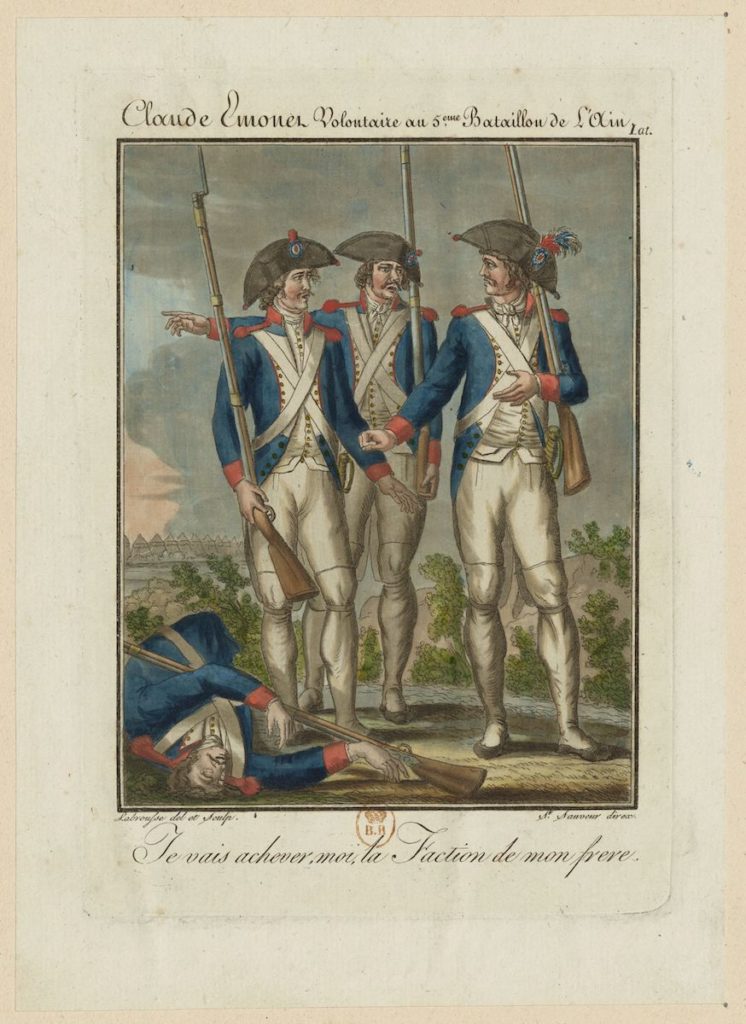
Indeed, the very markets portrayed by Grasset, once securely controlled by the French, had become increasingly contested by the second half of the century. During the Seven Years’ War, the British in 1758 captured both Gorée and Saint-Louis, representing their first direct conflict over West African possessions.[26] In capitulation negotiations, Britain restored Gorée to France in 1763 but retained Saint-Louis until the French recaptured it in 1779.[27] With this French-British conflict ongoing, in the 1770s African leaders of nearby Islamic states blocked river and overland routes critical to French slave trade operations as a way to intervene in the enslavement of Muslims specifically. Lastly, the habitants of Saint-Louis, cognizant of their centrality to French commerce, protested their exclusion from French mercantile protections and, in a list of grievances presented to the Estates-General in 1789, asserted their blood-kinship to France based on centuries of intermarriage between European men and signares. That these events in Senegal were of significant interest to metropolitan French consumers is evidenced by repeated references to them in a number of contexts. Pro-slavery advocates cited the region’s commercial instabilities in their calls for more extensive governmental trade regulations. With the same news, meanwhile, abolitionists underscored the fundamental incompatibility of the “unnatural” condition of enslaved men and women with the revolutionary ideals of natural freedom from illegitimate political rule.[28] This demand for information, for clarity about the Senegalese people and markets, informed the creation and subjects of Grasset’s prints, which attempt to make difference, both racial and economic, visually recognizable at a time in which both were becoming more, rather than less, contested in French political debates.
Oversight and Instability
Grasset’s prints, as a commercial venture, partook from and contributed to the heightened visibility of Senegal’s slave trade in late eighteenth-century France. Yet their mercantile significance was certainly not limited to Grasset’s bottom line. They also participated in the production and circulation of a larger body of printed “oversight imagery” focused on the slave trade in relation to France’s global economy. As flexible signifiers that were borrowed, edited, and reproduced in many contexts, the agents and exchanges Grasset made visible were subsequently interpreted as evidence of, alternatively, African or European (im)morality in relation to ongoing debates about race and regulation. In my insistence upon the very real stakes of visualization as an act, I follow Mary Louise Pratt who has argued that travel literature, in the way it collected and ordered information about the world, asserted European hegemony through the act of representation itself.[29]
The term “oversight imagery” is further inspired by Nicholas Mirzoeff’s argument that the ability to assemble a visualization manifests the authority of the visualizer, an idea that draws on Michel Foucault’s insights about how hierarchical observation regulates modern disciplinary society. Mirzoeff refers to these techniques as “oversight” and examines them in relation to overseers’ surveillance of enslaved plantation laborers. The plantation complex of visuality, as he calls it, relied on the separation of space into “defined slave space and ‘free’ space” using not only physical architecture but also legal and social codes.[30] This created a regime of taxonomy, observation, and enforcement to sustain a visualized domain of the social and political that came to be known as “economy,” he argues, thereby drawing a direct connection between the visuality of oversight and the conditions of economic production under slavery.[31] The visible surface of bodies both real and represented came to play a central role in this configuration, as skin color was increasingly defined as a natural and immutable index of human difference over the course of the eighteenth century.[32] Although Grasset’s prints represent many historically accurate details about the diverse actors in Senegal’s slave trade, it is essential to recognize that they simultaneously functioned as oversight images that surveilled and promulgated the racial categorization of all Africans, free and enslaved.
The printed corpus of European oversight imagery expanded dramatically in the eighteenth century and, due to frequent copying and recontextualization of images, created a sort of visual echo chamber that continually reinscribed the racial differences depicted therein. Grasset’s cognizance of recent travel literature and related genres—his own oversight of this printed field—coupled with his ability to combine appropriated texts and images in new ways was vital to his commercial success. Julie Alix appropriately describes him as “a hungry smuggler” who carved out an enviable, profitable place in the Republic of Letters.[33] Lafont and Mia Bagneris have both connected works by Grasset to earlier paintings and prints by Agostino Brunias (c.1730-1796) of the Caribbean, whose expanding commercial importance prompted greater oversight of all kinds. Anna Arabindan-Kesson has argued that Brunias’s attention to the interconnectedness of the visual logic of representation and the economic logic of commerce emphasized the Caribbean as a transactional space framed by a mobile economy.[34] Grasset further mobilized these Caribbean market subjects, as he was one of few designers who recognized and capitalized on the graphic opportunities offered by Brunias’s visual and aesthetic grammar.[35]
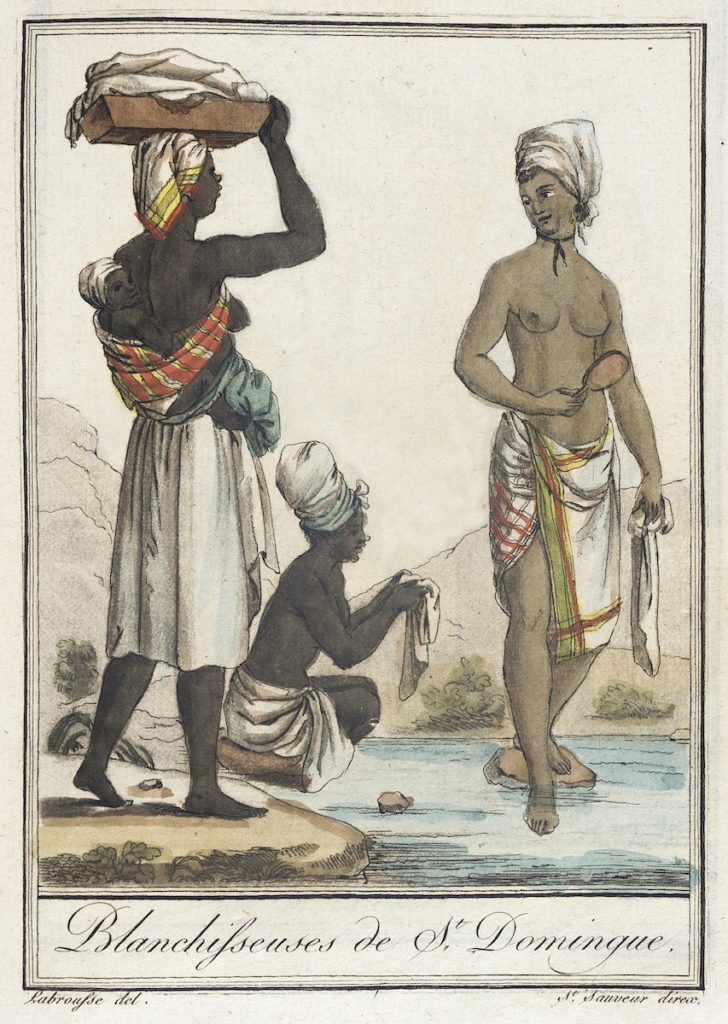
With this understanding of Brunias in mind, we can see that Grasset embraced and redeployed Brunias’s attention to mercantilism in his own prints by depicting Senegalese signares as noteworthy commercial consumers. This dynamic is exemplified in Grasset’s 1796 Blanchisseuses de St. Domingue (Fig. 7) which replicates, in reverse, the basic figural composition of Brunias’s 1779 print, The West Indian Washer-Women (Fig. 8). Three women of color, one with a baby on her back, stand or kneel near a shallow body of water; all wear white headscarves and wrappers around their waists while their breasts remain uncovered. Both titles emphasize the women’s occupation as laundresses, thereby framing their titillating partial nudity as commonplace scenes of everyday labor. Although Grasset’s hand-colored etching abandons the earlier work’s detailed attention to the lush Caribbean landscape, it echoes Brunias’s careful delineation of the women’s clothing and more coarsely exaggerates differences in their skin colors. Brunias strategically centered fashionable, mixed-race women with lighter skin in paintings such as Linen Market, Dominica (c. 1780; Fig. 9). In doing so, Kay Dian Kriz reminds us, Brunias relegated women with darker skin to the periphery to communicate the Caribbean’s potential for social and economic refinement.[36]
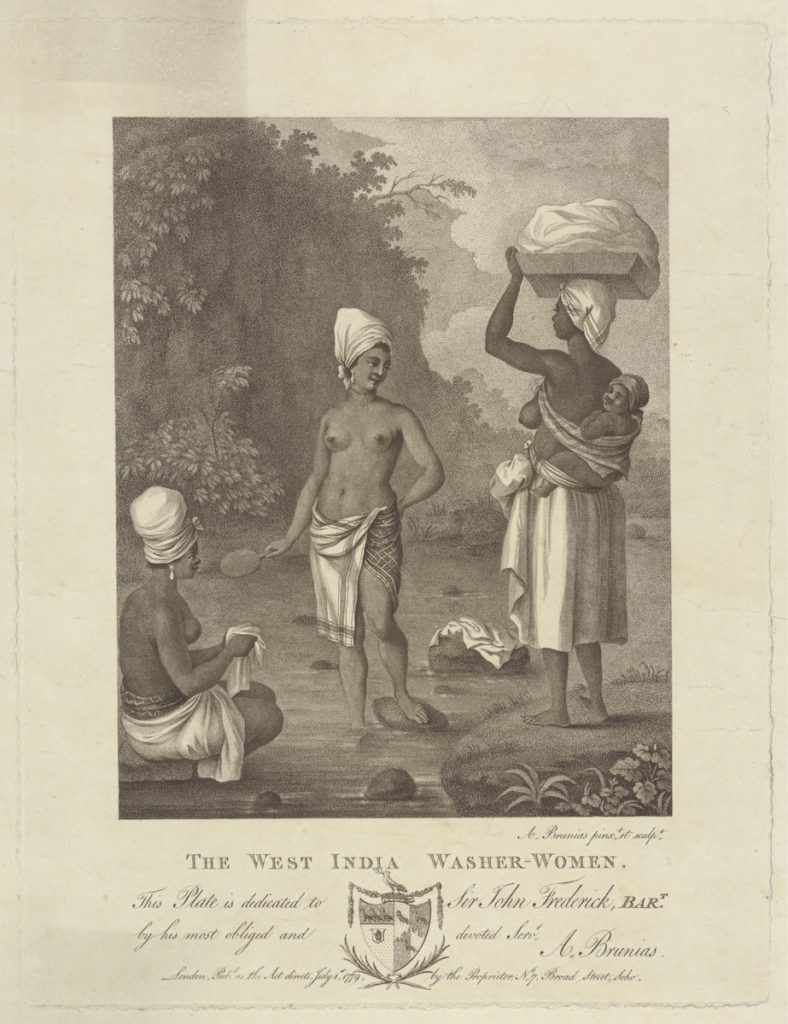
The 1796 Blanchisseuses print shares this attentiveness to visual markers of difference within a Black-majority community with not only Brunias’s oeuvre but also Grasset’s own representation of the Senegalese signare and her enslaved aide made the following year (Fig. 3). Indeed, the compositional arrangement of the signare and her parasol-holding attendant resembles, and may appropriate, the pair of women under the red parasol in Linen Market by Brunias. Of vital importance, however, is the shift in the West African image from skin color to clothing as the main formal signifier of difference. Unlike in Brunias’s work, the skin colors of the signare and her attendant are identical—it is instead their possessions (or lack thereof) that communicate class status and, more importantly, buying power. Capable of purchasing both fashionable attire and enslaved labor, the signare’s economic agency is emphasized. After all, the signares were largely defined by the social visibility of their financial security, which, Olivette Otele notes, was made possible through family networks in Gorée, Saint-Louis, Nantes, or Bordeaux.[37] Grasset’s travel and costume images effectively advertised the signares’ buying power and, as Jody Benjamin has shown, communicated details about Senegalese taste and cultural practices to French merchants seeking business ventures abroad.[38] The circulation of these oversight images furthered the perception of habitants as doubly important to French markets as key commercial agents and as consumers of imported goods.
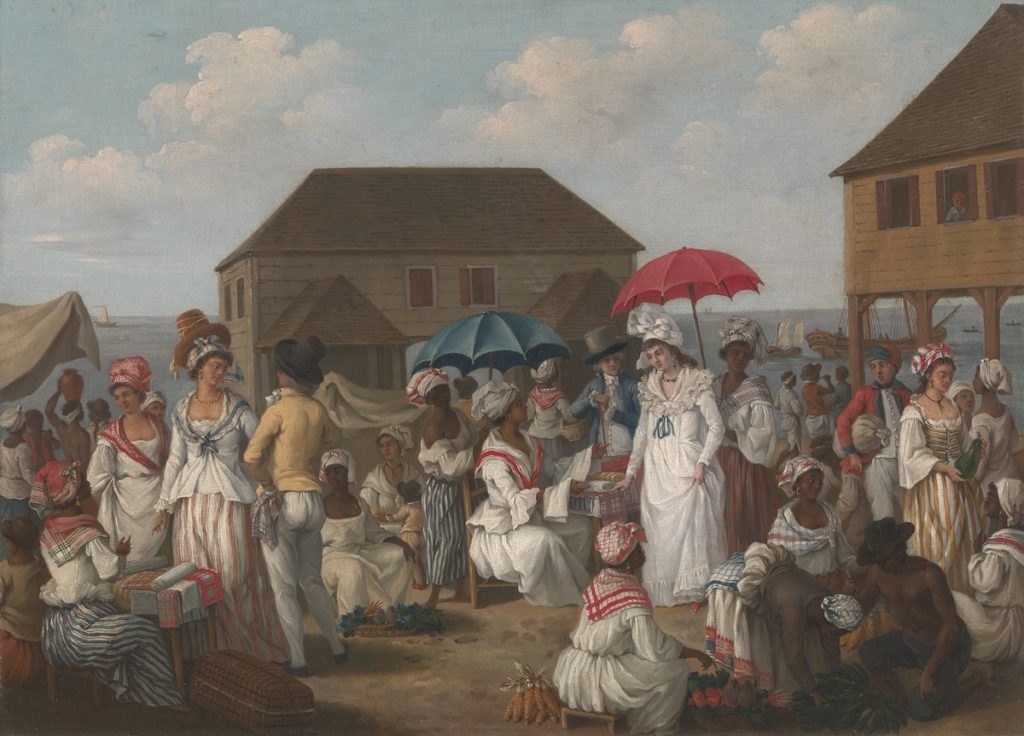
French mercantile interests in Senegal were far from secure by mid-century due to intense competition for control over the region’s markets and the skilled labor of the habitants. The struggle between European imperial powers was undoubtedly stoked, at least in part, by the increasing circulation of prints touting West Africa’s resources and markets. While the last quarter of the eighteenth century is widely associated with political revolutions reshaping the British and French empires, as well as their American colonies, this history cannot be separated from the concurrent turmoil in western Africa with which it was politically and economically imbricated. James F. Searing argued that the primary goal of Britain’s mid-century incursions into the region was the “colony” of Saint-Louis because the habitants and enslaved women and men were recognized as essential agents and buyers in the transatlantic trade.[39] Mergers, bankruptcies, and the forced reallocation of concessions also frequently disrupted operations for French trading companies in Lower Senegal. By the eve of the Revolution, however, France was nonetheless transporting more enslaved people across the Middle Passage than any other European power.[40] Angered by the increasing enslavement of African Muslims, in 1776 a group of Fulbe Muslim clerics led by Abdul Qader Kan (c. 1725-1806) seized power in the nearby interior region of Futa Tooro and banned all slave trading with Saint-Louis. Over the next thirty years, Kan launched expansionist military campaigns aimed at reordering relations among clerics, politicians, and merchants, both local and foreign. Yet the reformers’ outrage did not challenge the legality of non-Muslim slaves and was not a total rejection of trade with Europeans, but rather an insistence that it should only occur within certain parameters.[41] The military action taken by West African clerics and politicians, then, should be understood as part of ongoing international debates about not only trade regulation but when—and for whom—slavery becomes unacceptable.
Regulating Race
The circulation of Grasset’s oversight imagery in France coincided with calls for increased regulation of the Senegalese slave trade and for more expansive political liberties, which some argued should include the habitants and other free people of color in French colonies. Social and economic circumstances for the Eurafrican community in West Africa had changed significantly during the second half of the century. French, and later British, officials at Saint-Louis and Gorée established European-style legal codes that permitted habitants to acquire property, bequeath dwellings and possessions to descendants, and exercise civic responsibilities.[42] The resulting stabilization of wealth also enabled more habitants to purchase slaves.[43] Although still landless dependents, the conditions of enslaved persons in Saint-Louis appeared relatively unregulated to observers accustomed to plantation-based slavery across the Atlantic. Foreigners often remarked on their struggle to differentiate between free and enslaved persons because skin color alone was an unreliable indicator, as Grasset’s representations of Black and métis slave traders and owners respectively indicate (see Figs. 1 and 3). Captain Thomas Wilson, a British royal navy officer working in Gorée in the 1780s, noted that the habitants had “many” slaves but lamented: “It is not an easy matter to distinguish them from their masters or mistresses; they live all together.”[44] The difficulty of recognizing enslaved from free people on the basis of sight alone provoked anxieties around social differentiation that works like those by Grasset attempted to fill through his attention to other visible markers, such as elaborate or fashionable clothing.
Despite the new laws, in the last decade of the century, many habitants in Saint-Louis expressed discontent about labor conditions, compensation, and, most emphatically, their exclusion from certain privileges extended to French merchants. Their complaints are articulated in the forty-page cahier des doléances, or list of grievances, that opens the text L’Afrique et le peuple africain (1789) by French commercial agent Dominique Harcourt Lamiral (1751-1800), who presented it on behalf of the habitants to the French Estates-General in 1789. As Lisa Ze Winters points out, this petition was one of a series of protests conveyed by the habitants of Saint-Louis and Gorée during the second half of the century. And theirs were not alone: in the same year, cahiers de doléances flowed from nearly every sector of French society to the newly reinstated Estates-General.[45] Through the very act of creating such a list, then, the habitants claim their right to participate in the French legal system as revolutionary actors. Central to the habitants’ grievances was the fact that their social and economic mobility remained dependent on their proximity, primarily through biological kinship, to European authority because they were not legally recognized as French.[46] In their cahier, the habitants protest the unfair trade relationships enforced by the Compagnie du Sénégal and assert their rights as men made French by virtue of their blood-kinship to France via the signares. Such an emphasis on blood as a marker of social identity, rather than skin color, attests to the ways in which the corporeal markers of race were still being negotiated. Michaud has argued that while race was a porous signifier, central to all uses was the idea that a given human group had a common origin and that it was blood that ensured the hereditary transmission of certain physical characteristics.[47] So although skin color, per se, was not central to the habitants’ complaint (and was likely perceived as a barrier), the framing of their physical bodies as the literal product of the French state’s mercantile actions was fundamental to their petition.
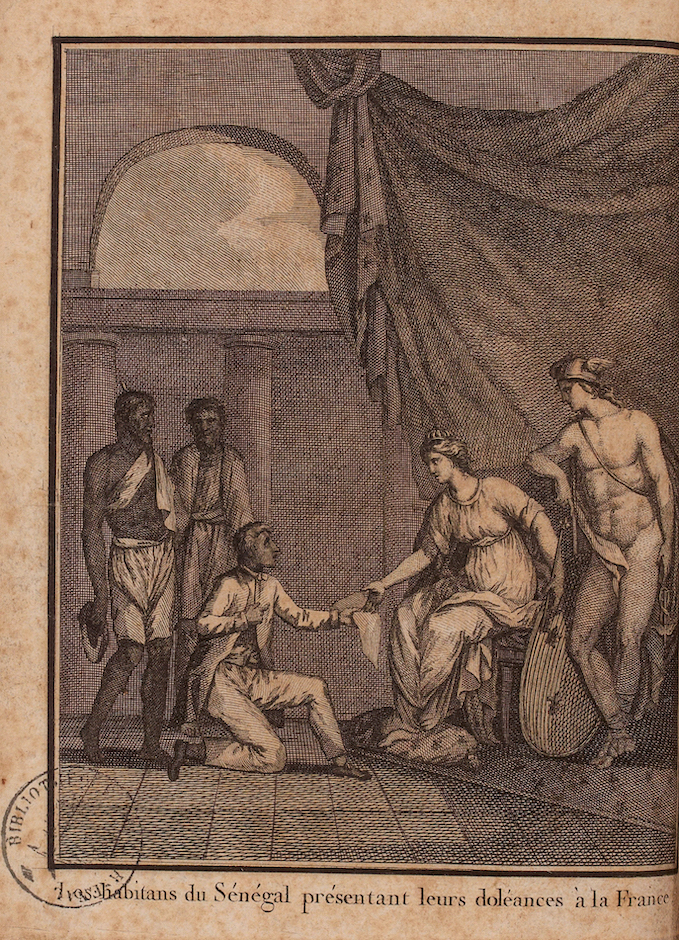
The frontispiece of Lamiral’s book dramatizes the moment in which the habitants’ complaints are presented to France (Fig. 10). As a supplicating mediator, Lamiral kneels between two men of color, identified by the title as Senegalese habitants, who stand behind him at left and the enthroned, female allegory of France at right attended by a nearly nude Mercury. Coupled with the large draped textile embossed with fleur-de-lis, the encompassing neoclassical architecture suggests the setting is metropolitan France. This setting was an important precondition for the validity of presenting a race-related grievance. According to the early modern legal maxim, “There are no slaves in France,” any enslaved person who stepped foot onto metropolitan French soil could petition for their freedom. This process was occasionally successful when petitions were tried in Paris, as Sue Peabody has demonstrated.[48] However, the increasing number of legal cases involving Black plaintiffs led French authorities to create a special unit in 1777 known as the Police des Noirs, which perpetuated the assumption, as Otele has argued, that all Black bodies were also enslaved.[49] Like Grasset’s prints, this frontispiece operates as an oversight image insofar as it visually reinscribes the association between slavery and the legal complaints of people of color that was already present in the French imaginary. Unrepresented in this image is its central paradox: while the Senegalese petitioners sought redress for injustice, both they and Lamiral ardently supported slavery and la traite.
Senegal played a unique and prominent role in French debates about slavery. In his own text following the cahier des doléances, Lamiral highlighted the trade’s profitability and emphasized the proximity that a French presence in Senegal provided to “huge treasures” in the interior tropics.[50] Other proslavery writers similarly emphasized Senegal’s economic potential, but only if accompanied by French regulatory oversight. The merchant Pruneau de Pommegorge (1720-1812) wrote in 1789 that the “Senegal River…offers at least many, many more, riches for France as America did for the Spaniards and the Portuguese. It [France] can also possess it all in a very few years by protecting what is indigenous instead of destroying it.”[51] Jean-Baptiste-Léonard Durand (1742-1813), a Compagnie du Sénégal administrator, encouraged state-sponsored assistance for African farmers who would then “provide France with inexhaustible resources.”[52] By justifying regulation as a way to ameliorate the conditions of free and enslaved laborers’ lives, proslavery writers deployed rhetoric connected to the Enlightenment ethic of benevolence and the cult of sensibility’s emphasis on “finer feelings.” The policies they championed, however, aimed to extract maximum profitability by quelling resistance, lengthening the lives of the enslaved, and reducing violence by enslavers.[53] Regulatory concerns and mercantilist language also informed abolitionist discourse, as well as debates about personal and political liberty. Founded in 1788 as France’s first abolitionist organization, the Société des amis des Noirs sought the abolition of the slave trade, rather than emancipation, as they focused on the tyranny of political institutions that limited a state of natural freedom.[54] This attention to metaphorical intersections between slavery and governmental overreach was not unique. Anoush Fraser Terjanian has shown that the term esclave appeared with increasing frequency in several eighteenth-century genres as slavery metaphors became a common way to conceptualize relations to absolute authority. Despotism came to be regarded as the Frenchman’s “chains.”[55]
A 1791 engraving titled Discussion sur les hommes de couleur purportedly celebrates such a breaking of corporeal and political chains (Fig. 11). The print references the Constituent Assembly’s decree on May 15, 1791, that gave certain rights to men of color born to free fathers and mothers, including the right to vote in colonial assemblies. A chaotic mélange of iconographic signifiers, including palm trees, a ship, chains, and a barrel, emphatically link this scene to the oversight images by Grasset and others representing the movement of people and goods across France’s transatlantic economy. Yet the heroic intervention of recognizable French politicians is the print’s undeniable focus: Jacques Pierre Brissot (1754-1793), a founder of the Amis, unshackles men of color in the foreground, while Jérôme Pétion de Villeneuve (1756-1794), the Mayor of Paris from 1792-1793, soars above the scene as an allegory of Justice accompanied by Maximilien Robespierre (1758-1794) as Humanity and Abbé Grégoire (1750-1831) as Reason. Abbé Grégoire had campaigned for rights of freed men of color in his Mémoire en faveur des gens de couleur (1789), which Pétion had further defended in his Discours sur les troubles de Saint-Domingue (1790).[56] In depicting the physical breaking of chains, however, the print conflates a (temporary) political victory for free men of color with total emancipation.[57] Not only did slavery remain legal in France until 1794, but abolition was in fact antithetical to the political and economic demands of many free people of color, including the Senegalese habitants. Like Lamiral’s frontispiece, then, the print collapses the differing opinions toward slavery and la traite held by people of color throughout the French empire through its visual insistence on the categorical association between a non-white racial identity and slavery.
Conclusion – Saviorism and Shipwrecks
Despite their oppositional political stances, the French abolitionists allegorized in the 1791 Constituent Assembly print echo the representation of Lamiral supplicating before France in the 1789 frontispiece. The figures all function as intercessors who negotiate legal and economic terms between a group of men of color and French political institutions. It is a role not entirely dissimilar to contemporary “white saviors” who use their relative privilege to intervene in communities other than their own, often while drawing substantial attention to their own altruism in the process (and garbling the actual discontents at hand). In their claims to speak for the interests of people of color in France and its colonies, both abolitionists and proslavery defenders reinscribed their own discursive agency and moral authority. Lamiral only briefly acknowledges his own complicit positionality, noting, “And we dare call a barbarian a people we drag in irons.”[58] Similar accusations of barbaric or savage behavior were targeted at both Europeans and Africans in the period. As my concluding examples I hope make clear, these charges were interconnected with the central tension I see in Grasset’s prints between the desire to make racial difference visible, on one hand, and, on the other, the unreliability of perception—what we might call the limits of “oversight”—in discerning identity in relation to legal status, race, and moral character.
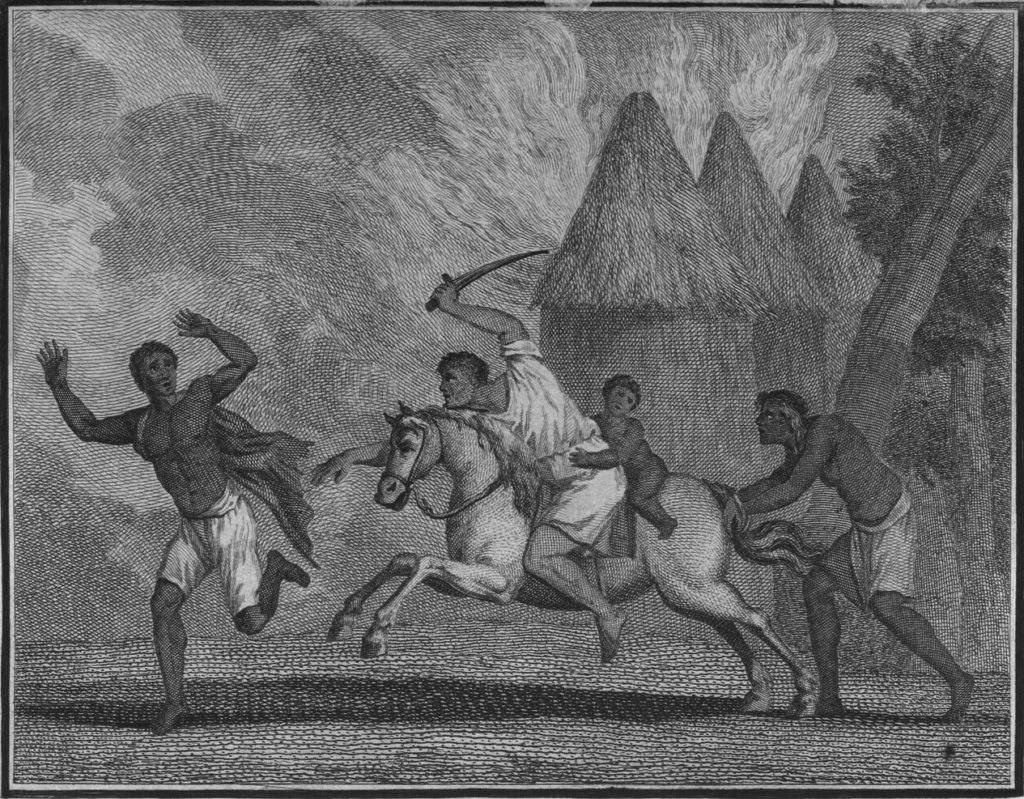
After presenting the habitants’ list of grievances in L’Afrique et le peuple africain, Lamiral went on “to paint truthfully and frankly the mores” of the Senegalese people that, as in my opening quote from Grasset, comparatively emphasizes their temperamental and moral deficiencies.[59] In this text, to my surprise, I again encountered the image of a mounted rider chasing a figure on foot (Fig. 12) that I first came across in Grasset’s Costumes (Fig. 4) as well as in his earlier Encyclopédie des voyages (1796; Fig. 13). Although this image may appear in another work before 1796, the 1789 date of Lamiral’s book predates most of Grasset’s illustrated publications. This, then, may be the source from which Grasset appropriated one of his key images of the Senegalese trade. While the works’ compositions are almost identical, Lamiral’s title provides a completely different context, although an equally unsettling one: Sénégal. Femme adultère trainée par un cheval et son amant pourchassé. Rather than a scene of enslavement, the representation is framed as a scene of discipline and punishment (and provides a much clearer explanation for the child). Such radical re-contextualizations of text-image relationships are not new business for art historians, particularly those attentive to travel literature, as Christopher B. Steiner and others have demonstrated.[60] Yet it nonetheless underscores how a single composition focused on violent pursuit and captivity was deployed as evidence for different examples of West Africans’ supposed moral inferiority in the late eighteenth century.

Several scholars have examined how similar displacements of behavior condemned as savage or barbaric proliferated in print as a way to grapple with violence in contested imperial spaces. Following Britain’s usurpation of Jamaica, Kriz argues that Spain, because of its spectral presence, became a site for displacing colonial guilt and was framed as particularly barbarous for its extermination of the Indigenous Arawak population.[61] In eighteenth- and nineteenth-century European literature, Senegal specifically came to be associated with shipwrecks and the ensuing “savage” torture of survivors by hostile coastal inhabitants, often identified as Moors. Such wrecks, Darcy Grigsby has claimed, made it highly uncertain who was and who was not a cannibal as both Africans and Europeans circulated stories about the other’s taste for flesh. Black Africans came to be so closely associated with cannibalism that French slave trader Louis de Grandpré (1761-1846) had to clarify in his 1801 Voyage à la côte occidentale d’Afrique that Africans in fact thought that it was Europeans who ate men.[62]
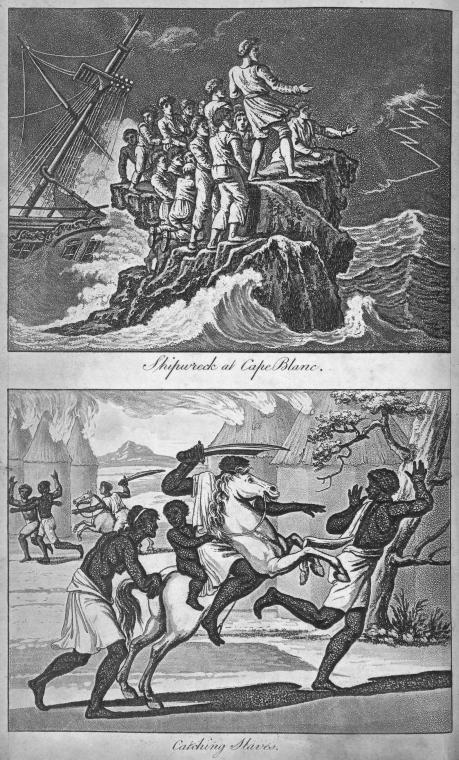
Imagine my disbelief when, while consulting the English translation of a similar, popular travel account, Durand’s A Voyage to Senegal (1806), the pursuit image used by Lamiral and Grasset appeared again, now with the title “Catching Slaves,” directly beneath a shipwreck scene (Fig. 14). This particular juxtaposition of a shipwreck scene and one of enslavement suggests the possibility of the breakdown of racial and economic differences feared by Europeans—namely, the capture and enslavement of white Europeans by Africans. Although the figures in the “Catching Slaves” illustration are all Black, the image’s physical proximity to the shipwreck scene above, which includes both white men and men of color, suggests a similar fate may await survivors who reach the Senegalese coast.
While individual signifiers could be quite flexible within French oversight imagery, the print corpus as a whole operated as a visual echo chamber that repeatedly reinscribed the stakes, both economic and moral, of the racial difference depicted therein. The final example above in fact recalls Grasset’s own moralizing call to action in his tale of Mademoiselle de Bourk’s shipwreck and enslavement in Africa in La belle captive. After chastising French consumers of foreign luxury products for exposing Christian merchants to violence, Grasset calls for European military intervention “to impose on these pirates the heart’s first law: humanity.”[63] The deep irony lies of course in Grasset’s anti-capitalist, xenophobic critique of the very global markets that his prints helped publicized in the late eighteenth-century French imaginary. But perhaps this call, too, is a strategic attempt to sell more books, to capture more market share, and is thus not that dissimilar from other petitions for regulation when instabilities and transgressions, whether moral, economic, or racial, threatened to destabilize imperial markets.
Katherine Calvin is Assistant Professor of Art History at Kenyon College, OH.
[1] Jacques Grasset de la Saint-Sauveur, Tableaux des principaux peuples de l’Europe, de l’Asie, de l’Afrique, de l’Amérique, et les découvertes des capitaines Cook, La Pérouse, etc... (Paris: Chez l’Auteur, 1797), 252. “L’homme noir est mon frère, je le sais, et le colon qui veut le mettre au niveau des bêtes, pour en tirer le même parti, est un barbare.” All translations are my own unless otherwise stated.
[2] Grasset, Tableaux des principaux peuples, 252:“cependant, en dépit de la philosophie, il y a une nuance entre lui et le blanc, et cette nuance n’est pas imperceptible…Il pense comme un enfant et se corrompt comme un homme.”
[3] See Roxann Wheeler, The Complexion of Race: Categories of Difference in Eighteenth-Century British Culture (Philadelphia: University of Pennsylvania Press, 2000).
[4]Anne Lafont, “How Skin Color Became a Racial Marker: Art Historical Perspectives on Race,” Eighteenth-Century Studies 51, 1 (2017): 95. See also Lafont, L’art et la race: l’Africain (tout) contre l’œil des Lumières (Paris: Les presses du réel, 2019).
[5] Éric Michaud, The Barbarian Invasions: A Genealogy of the History of Art, trans. Nicholas Huckle (Cambridge: The MIT Press, 2019), 40.
[6] Chantal Turbide, “Jacques Grasset de Saint-Sauveur et les costumes des Sauvages du Canada, Eighteenth-Century Fiction 23, 4 (2011): 644.
[7] Douglas Fordham, Aquatint Worlds: Travel, Print, and Empire, 1770-1820 (New Haven: Yale University Press, 2019), 21.
[8] For more on this legal case, see J. F. Bosher, “The French Government’s Motives in the Affaire du Canada, 1761-1763,” The English Historical Review 96, 378 (1981): 59-78.
[9] Turbide, “Jacques Grasset,” 638-640; Jody Benjamin, “Clothing as a Map to Senegambia’s Global Exchange at the Turn of the Nineteenth Century,” in Dressing Global Bodies: The Political Power of Dress in World History, eds. Beverly Lemire and Giorgio Riello (London: Routledge, 2019), 143.
[10] This biographical note is inserted in Alphonse Rabbe’s Universal and Portable Biography of Contemporaries (Paris: Y. de Boisjolin, 1830). Bernard Andrès, “Jacques Grasset de Saint-Sauveur (1757-1810), aventurier du livre et de l’estampe,” Les Cahiers des dix 56 (2002): abstract.
[11] The bibliography compiled by Andrès attributes to Grasset sixteen travel and costume encyclopedias; seven libertine fictions; and thirteen additional books on subjects from global mythology to notable actors. “Jacques Grasset de Saint-Sauveur (1757-1810), aventurier du livre et de l’estampe,” Les Cahiers des dix 57 (2003): 345-349.
[12] Andrès, “Jacques Grasset de Saint-Sauveur,” (2002), 204.
[13] Andrès, “Jacques Grasset de Saint-Sauveur,” (2003), 326. Grasset’s success can be understood in relation to the growing demand for relatively affordable prints of the latest fashions. According to Kristel Smentek, genre prints dominated the market from 1787-89 in part because of the ongoing consumer revolution in France that motivated buyers to purchase prints for their newness alone, which may have superseded interest in the depicted subjects themselves. See “Sex, Sentiment, and Speculation: The Market for Genre Prints on the Eve of the French Revolution,” Studies in the History of Art 72 (2007): 222.
[14] Turbide, “Jacques Grasset de Saint-Sauveur,” 641.
[15] Albert B. Elsasser compares the popularity of Grasset’s works to those produced by Jesuit authors writing about California. “Grasset de Saint Sauveur and the Indians of Baja California,” The Journal of California Anthropology 3, 2 (1976): 34.
[16] Desrais is mentioned for his commercial success in fashion prints by Gerrit Walczak in “Low Art, Popular Imagery and Civic Commitment in the French Revolution,” Art History 30, 2 (2007), 260; and by Meredith Martin in “Tipu Sultan’s Ambassadors at Saint Cloud: Indomania and Anglophobia in Pre-Revolutionary Paris,” West 86th: A Journal of Decorative Arts, Design History, and Material Culture 21, 2 (2014), 50, 60.
[17] Benjamin identified a similar Senegambian emphasis (25 of the 66 plates) in Grasset’s Encyclopédie des Voyages (1796), which shares some plates with Costumes. “Clothing as a Map to Senegambia’s Global Exchange,” 145.
[18] George E. Brooks, Eurafricans in Western Africa: Commerce, Social Status, Gender, and Religious Observance from the Sixteenth to the Eighteenth Century (Athens: Ohio University Press, 2002), 122.
[19] Brooks, Eurafricans in Western Africa, xix.
[20] The French term habitant appears to have originated with the settlement of Africans around the Saint Louis fort after its construction in 1659, which was called l’habitation. For a broader study of race in Senegal, see Hilary Jones, The Métis of Senegal: Urban Life and Politics in French West Africa (Bloomington: Indiana University Press, 2013).
[21] Jones, The Métis of Senegal, 20.
[22] Brooks, Eurafricans in Western Africa, 250.
[23] Sarah Thomas, Witnessing Slavery: Art and Travel in the Age of Abolition (London: Paul Mellon Centre for Studies in British Art, 2019), 49. For an extended analysis of Morland’s painting, see Meredith Gamer, “George Moreland’s Slave Trade and African Hospitality: Slavery, Sentiment and the Limits of the Abolitionist Image,” in The Slave in European Art: From Renaissance Trophy to Abolitionist Emblem, eds. Elizabeth McGrath and Jean Michel Messing (London: Warburg Institute, 2012), 297-319.
[24] Joseph Clarke, “‘Valour Knows Neither Age Nor Sex’: The Recueil des Actions Héroïques and the Representation of Courage in Revolutionary France,” War in History 20:1 (2013): 67.
[25] Gillian Weiss, Captives and Corsairs: France and Slavery in the Early Modern Mediterranean (Stanford: Stanford University Press, 2011), 95, 113. The full title of Grasset’s text was La Belle captive, or True Story of the Shipwreck & the Captivity of Mlle. Adeline, Countess of St-Fargel, aged 16, in one part of the kingdom. of Algiers (1786).
[26] James F. Searing, “The Seven Years’ War in West Africa: The End of Company Rule and the Emergence of the Habitants,” in The Seven Years’ War: Global Views, eds. Mark Danley and Patrick Speelman (London: Brill, 2012), 263-264.
[27] James F. Searing, West African Slavery and Atlantic Commerce: The Senegal River Valley, 1700-1800 (Cambridge: Cambridge University Press, 1993), 27-32, 217-221.
[28] Daniel P. Resnick, “The Société des Amis des Noirs and the Abolition of Slavery,” French Historical Studies 7, 4 (1972): 559-560.
[29] See Mary Louise Pratt, Imperial Eyes: Travel Writing and Transculturation, 2nd ed. (London: Routledge, 2007).
[30] Nicholas Mirzoeff, The Right to Look: A Counterhistory of Visuality (Durham: Duke University Press, 2011), 2, 10-11.
[31] Mirzoeff, The Right to Look, 48-50.
[32] Lafont, “How Skin Color Became a Racial Marker,” 109; Wheeler, The Complexion of Race, 91-136.
[33] Julie Alix, “Jacques Grasset de Saint-Sauveur (1757-1810) ou la littérature des marges à la fin d l’Ancien Régime et sous la Révolution,” in Portrait des arts, des lettres, et de l’éloquence au Québec (1760-1840), eds. Bernard Andrès and Marc Andre Bernier (Québec: Presses de L’Université Laval, 2002), 115.
[34] Anna Arabindan-Kesson, Black Bodies, White Gold: Art, Cotton, and Commerce in the Atlantic World (Durham: Duke University Press, 2021), 76.
[35] Anne Lafont, “Fabric, Skin, Color: Picturing Antilles’ Markets as an Inventory of Human Diversity,” Anuario Colombiano de Historia Social y de la Cultura 43, 3 (2016): 130; Mia Bagneris, Colouring the Caribbean: Race and the Art of Agostino Brunias (Manchester: Manchester University Press, 2017), 227.
[36] Kay Dian Kriz, Slavery, Sugar, and the Culture of Refinement: Picturing the British West Indies, 1700-1840 (New Haven: Yale University Press, 2008), 37-69.
[37] Olivette Otele, African Europeans: An Untold History (London: Hurst & Company, 2020), 105.
[38] Benjamin, “Clothing as a Map,” 142.
[39] Searing, “The Seven Years’ War in West Africa,” 263-264.
[40] The Compagnie Française des Indes incorporated a number of other privileged companies in 1719, including the Compagnie du Sénégal (which had gone bankrupt in 1709 though the name continued to be used). In 1725 it began selling trading permits to independent businessmen, which further decentralized the company’s market control. Brooks, Eurafricans in Western Africa, 123-124; William Doyle, “Slavery and Serfdom,” The Oxford Handbook of the Ancien Régime (London: Oxford University Press, 2012), 269.
[41] Benjamin, “Clothing as a Map,” 147.
[42] Brooks, Eurafricans in Western Africa, xxiii.
[43] Searing, West African Slavery and Atlantic Commerce, 55-56.
[44] Quoted in Searing, West African Slavery and Atlantic Commerce, 50.
[45] Lisa Ze Winters, The Mulatta Concubine: Terror, Intimacy, Freedom, and Desire in the Black Transatlantic (Athens: University of Georgia Press, 2016), 113-114.
[46] Jones, The Métis of Senegal, 22.
[47] Michaud, The Barbarian Invasions, 40.
[48] Sue Peabody, ‘There Are No Slaves in France’: The Political Culture of Race and Slavery in the Ancien Régime (Oxford: Oxford University Press, 1996), 4.
[49] Otele, African Europeans, 84-85.
[50] Boubacar Barry, The Kingdom of Waalo: Senegal Before the Conquest (New York: Diasporic Africa Press, 2012), 133.
[51] Quoted in Barry, The Kingdom of Waalo, 134.
[52] Quoted in Barry, The Kingdom of Waalo, 134.
[53] See Sarah Thomas “Envisaging a Future for Slavery: Agostino Brunias and the Imperial Politics of Labor and Reproduction.” Eighteenth-Century Studies 52, 1 (2018): 111-133; Matthew Wyman-McCarthy, “Perceptions of French and Spanish Slave Law in Late Eighteenth-Century Britain,” Journal of British Studies 57 (2018): 29-52.
[54] Resnick, “The Société des Amis des Noirs,” 559-560.
[55] Anoush Fraser Terjanian, Commerce and Its Discontents in Eighteenth-Century French Political Thought (Cambridge: Cambridge University Press, 2012), 69, 84-88. Terjanian notes that Diderot, for example, considered slavery objectionable not only for its fundamental immorality but also for its economic shortcomings because it transformed humans into non-renewable capital and exhausted a nation’s commodities. This “commerce in man,” he argued, could only be ended through the establishment of a different type of commercial transaction, one in which men, having regained “property of [their] person,” could freely exchange labor for income.
[56] Helen Weston, “The Oath of the Ancestors by Lethière ‘le mulâtre’: Celebrating the Black/mulatto Alliance in Haïti’s Struggle for Independence,” in An Economy of Colour: Visual Culture and the Atlantic World, 1660-1830, eds. Geoff Quilley and Kay Dian Kriz (Manchester: Manchester University Press, 2003), 183.
[57] The 1791 decree was rescinded in September of the same year, and the civic rights of Black and mixed-race men in French colonies remained tightly restricted through the early decades of the nineteenth century.
[58] Lamiral, quoted in Barry, The Kingdom of Waalo, 134.
[59] Dominique Lamiral, “Advertissement,” in L’Afrique et le peuple africain considérés sous tous leurs rapports avec notre commerce et nos colonies. De l’abus des privilèges exclusifs et notamment de celui de la Compagnie du Sénégal. Ce que c’est qu’une société se qualifiant d’Amis des noirs… (Paris: Chez Dessenne, 1789), n.p. Quoted in Winters, The Mulatta Concubine, 110.
[60] See Christopher B. Steiner, “Travel Engravings and the Construction of the Primitive,” in Prehistories of the Future: The Primitivist Project and the Culture of Modernism, eds. Elazar Barkan and Ronald Bush (Stanford: Stanford University Press, 1995), 202-225.
[61] Kay Dian Kriz, “Curiosities, Commodities and Transplanted Bodies in Hans Sloane’s Voyage to…Jamaica,” in An Economy of Colour, eds. Quilley and Kriz, 92.
[62] Darcy Grimaldo Grigsby, “Food Chains: French Abolitionism and Human Consumption (1787-1819),” in An Economy of Colour, eds. Quilley and Kriz, 157-58. See also Extremities: Painting Empire in Post-Revolutionary France (New Haven: Yale University Press, 2002), 165-236.
[63] Weiss, Captives and Corsairs, 95, 113.
Cite this article as: Katherine Calvin, “Overseeing Senegal: French Prints of the Late-Eighteenth-Century Slave Trade”, Journal18, Issue 13 Race (Spring 2022), https://www.journal18.org/6160.
Licence: CC BY-NC
Journal18 is published under a Creative Commons CC BY-NC International 4.0 license. Use of any content published in Journal18 must be for non-commercial purposes and appropriate credit must be given to the author of the content. Details for appropriate citation appear above.

